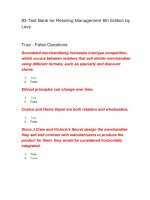Lecture Retailing management (6/e): Chapter 15 - Levy Weitz
Bạn đang xem bản rút gọn của tài liệu. Xem và tải ngay bản đầy đủ của tài liệu tại đây (1.56 MB, 60 trang )
Chapter 15
Pricing
McGrawHill/Irwin
Retailing Management, 6/e
Copyright © 2007 by The McGrawHill Companies, Inc. All rights reserved.
15-
Merchandise Management
Planning
Merchandise
Assortments
Retail
Communication
Mix
Pricing
Buying
Systems
Buying
Merchandise
2
15-
Why is Pricing Important?
Pricing decisions is important because customers have
alternatives to choose from and are better informed
Customers are in a position to seek good value
Value = perceived benefits
price
So, retailers can increase value and stimulate sales by
increasing benefits or reducing price.
3
154
Considerations in Setting Retail Prices
The four factors retailers consider in setting retail prices:
•
•
•
•
The price sensitivity of consumers
The cost of the merchandise and services
Competition
Legal restrictions
155
Considerations in Setting Retail Prices
15-
Price Setting Approach Used by Retailers
6
• Need to set price for 1000’s of products
many times during year
• Set prices based on pre-determined
markup and merchandise cost
• Make adjustments to markup price based
on customer price sensitivity and
competition
15-
Price Sensitivity and Demand
When
price
increases
sales
can decrease
as fewer customers feel the product is a good value
7
15-
Types of Price Discrimination
8
• First Degree – Set unique price for each customer equal to
customer’s willingness to pay
– Auctions, Personalized Internet Prices
• Second Degree – Offer the same price schedule to all
customers
– Quantity discounts
– Coupons
– Markdowns Late in Season
– Early Bird Special
– Over Weekend Travel Discount
• Third Degree – Charge different groups different prices
– Kids Menu
– Seniors Discounts
15-
Results of Price Experiments
9
Quantity Sold at Different Prices
1510
Profit at Different Prices
1511
Price Elasticity
1512
Elasticity = percent change in quantity sold
percent change in price
Price Elasticity
Elasticity = percent change in quantity sold
percent change in price
= (new quantity sold – old quantity sold)/old quantity sold
(new price – old price)/(old price)
= (1100-1500)/1100
(10-9)/9
= -0.2667
.1111
= -2.4005
1513
Price Elasticity
1514
For products with price elasticities less than -1, the price that maximizes
profits can be determined by the following formula:
Profit maximizing price = price elasticity x cost
price elasticity +1
Competitive Price Data
1515
1516
How Can Retailers Reduce Price Competition?
• Develop lines of
private label
merchandise
• Negotiate with national
brands manufacturers
for exclusive
distribution rights
• Have vendors make
unique products for the
retailer
PhotoLink/Getty Images
Legal and Ethical Pricing Issues
1517
Price Discrimination
Predatory Pricing
Resale Price Maintenance
Horizontal Price fixing
Bait and Switch tactics
Scanned vs. Posted Prices
PhotoDisc/Getty Images
Example of Markups
Retail = Cost + Markup
100% = 70% + 30%
Retail = $10.00 and markup = 30%
Retail = Cost + Markup
$ 10.00 = $7.00 + $ 3.00
1518
Retail Price and Markup
1519
Retail Price
$125
Margin
$50
Markup as a Percent
of Retail Price
40% = $50/$125
Cost of
Merchandise
$75
Retail Price = cost + markup
Markup Percent
1520
Markup percent is a markup as a percentage of the retail price.
Markup percent = retail price – cost of merchandise
retail price
= 125 – 75
125
= 40%
Markups
1521
Initial markup – retail selling price initially
set for the merchandise minus the cost
of the merchandise.
Maintained markup – the
actual sales realized for the
merchandise minus its costs
Rob Melnychuk/Getty Images
Initial and Maintained Markup
Reductions
$.10
Maintained
Markup
$.30
Maintained Markup as a
Percent of Retail Price
30% = $.30/$1.00
Initial Retail
Price $1.00
Cost of
Merchandise
$.60
1522
Example of Setting the
Initial Retail Price
Cost = $100
Planned Initial Markup = 56.85%
Retail Price = $100
+ (56.85% x Retail Price)
Solve for Retail Price
.4315 x retail price = 100
Retail Price = $100/.4315 = 231.75
Initial Retail Price = Cost of Merchandise
(1-markup percentage)
1523
Reasons for Taking Markdowns
• Get rid of slow-moving, obsolete,
uncompetitive priced merchandise
• Increase sales and promote merchandise
• Generate cash to buy additional
merchandise
• Increase traffic flow and sale of
complementary products generate
excitement through a sale
1524
1525
Liquidating Markdown Merchandise
PhotoLink/Getty Images
• Place merchandise on Internet auction site
• Sell the remaining merchandise to another
retailer
• Consolidate the unsold merchandise
• Give merchandise to charity
• Carry the merchandise over to the next season









